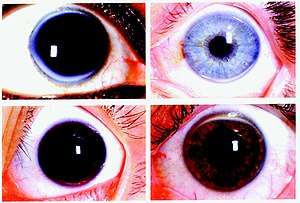Arcus senilis
Arcus senilis is an old age syndrome where there is a white, grey, or blue opaque ring in the corneal margin (peripheral corneal opacity), or white ring in front of the periphery of the iris. It is present at birth but then fades; however, it is quite commonly present in the elderly. It can also appear earlier in life as a result of hypercholesterolemia. Arcus senilis can be confused with the limbus sign, which reflects calcium rather than lipid deposits.
| Arcus senilis | |
|---|---|
| Other names | arcus adiposus, arcus juvenilis (when occurring in younger individuals), arcus lipoides corneae, arcus cornealis |
 | |
| Four representative slides of corneal arcus - arcus deposits tend to start at 6 and 12 o'clock and fill in until becoming completely circumferential. There is a thin, clear section separating the arcus from the limbus, known as the lucid interval of Vogt. Image from Zech and Hoeg, 2008.[1] | |
| Specialty | Ophthalmology |
Causes
It results from cholesterol deposits in or hyalinosis of the corneal stroma, and may be associated with ocular defects or with familial hyperlipidemia. It is common in the apparently healthy middle aged and elderly; a prospective cohort study of 12,745 Danes followed up for a mean of 22 years found that it had no clinical value as a predictor of cardiovascular disease.[2]
It can be a sign of disturbance in lipid metabolism, an indicator of conditions such as hypercholesterolemia, hyperlipoproteinemia or hyperlipidemia.
Unilateral arcus is a sign of decreased blood flow to the unaffected eye, due to carotid artery disease or ocular hypotony.
People over the age of 60 may present with a ring-shaped, grayish-white deposit of phospholipid and cholesterol near the peripheral edge of the cornea.
Younger people with the same abnormality at the edge of the cornea would be termed arcus juvenilis.
Diagnosis
Alternative names
It is also called arcus adiposus, arcus juvenilis (when it occurs in younger individuals), arcus lipoides corneae or arcus cornealis; sometimes a gerontoxon.
See also
References
- Zech Jr, LA; Hoeg, JM (2008). "Correlating corneal arcus with atherosclerosis in familial hypercholesterolemia". Lipids in Health and Disease. 7: 7. doi:10.1186/1476-511X-7-7. PMC 2279133. PMID 18331643.
- Christoffersen, M; Frikke-Schmidt, R; Schnohr, P; Jensen, GB; Nordestgaard, BG; Tybjærg-Hansen, A (15 September 2011). "Xanthelasmata, arcus corneae, and ischaemic vascular disease and death in general population: prospective cohort study". BMJ (Clinical Research Ed.). 343: d5497. doi:10.1136/bmj.d5497. PMC 3174271. PMID 21920887. Retrieved 27 November 2012.
External links
| Classification |
|---|